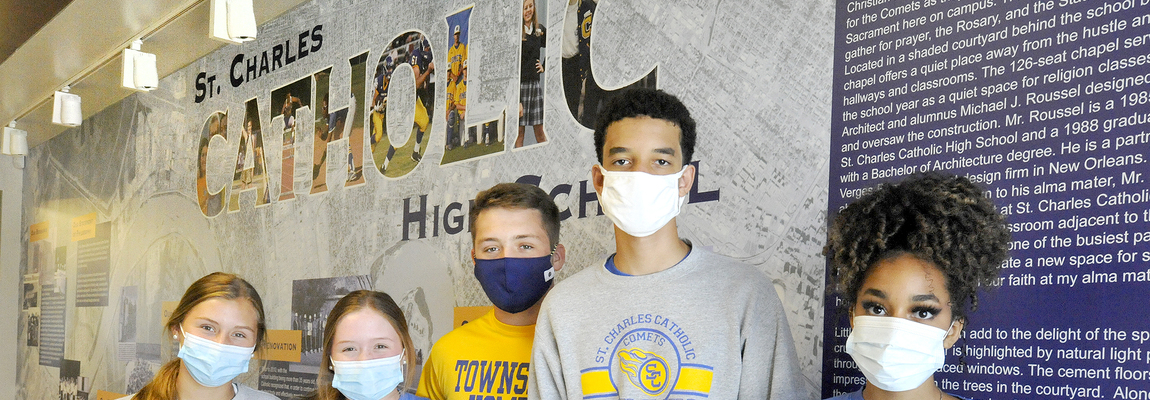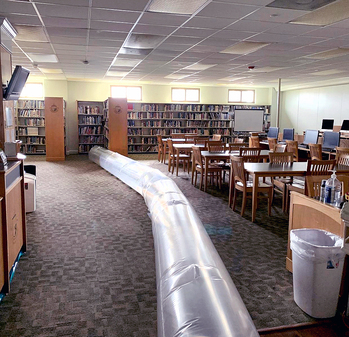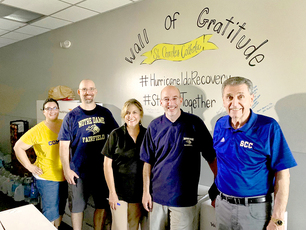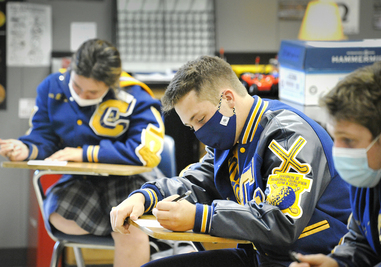
A platform that encourages healthy conversation, spiritual support, growth and fellowship

NOLACatholic Parenting Podcast
A natural progression of our weekly column in the Clarion Herald and blog

The best in Catholic news and inspiration - wherever you are!
St. Charles Catholic bands together in tough times
-

By Peter Finney Jr.
Clarion Herald
As a veteran of 33 years in Catholic schools, Tina Jeandron, a biology teacher at St. Charles Catholic High School in LaPlace, knows all about meticulous lesson preparation and the immutable laws of science.When water rushed into her home during Tropical Storm Isaac in 2012, making it unlivable for six months, a good friend loaned her family an RV so that they could live in their driveway while their house was being repaired.
Nine years later, Jeandron and her husband took no chances as Hurricane Ida approached, evacuating ahead of the storm to Orlando, Florida, where their two daughters live. The Jeandrons knew how vulnerable their house would be to an even more powerful storm.
Thinking of the road home
So, when Category 4 Ida flooded their house again, the Jeandrons were prepared for what she figured would be massive supply chain problems brought on by widespread devastation and COVID-19.
“We bought an RV,” Jeandron said. “We were in Orlando – which is the mecca of retirement – and then before we came home we stocked it with everything we needed to be able to gut the house.”
They forgot one thing.
“We’re still new to camping,” Jeandron said. “My husband backed up the RV into the driveway, and we learned our cord isn’t long enough to plug into the house. So, we’re on generator power right now, which is good because when the power’s out in the house, I’m not losing power in the camper.”
Faith and grit
Perseverance and faith have been the watchwords at St. Charles Catholic High School, where more than 90% of students and teachers had their homes affected in some way by Ida. Dr. Courtney Millet said three weeks after the storm passed and initial assessments have been made, eight teachers have been displaced because their homes were damaged to the point that they are unlivable.
And yet, Millet said, when St. Charles Catholic on Sept. 20 became the first high school to reopen in the civil parishes of St. John the Baptist, St. Charles and St. James, all of her teachers were back at work, some commuting from as far as Morgan City.
All but 15 of the school’s 413 students were back on campus despite many having to relocate to other homes with relatives and friends.
“The hardest challenge was that so many of our families had so much loss,” Millet said. “How were we going to help them deal with that? And then, second, how were we going to open our school as soon as we could?”
The drive to quickly reopen became even more apparent to Millet when the St. Charles Catholic football team, scattered since the storm, gathered for a team meeting with head coach Wayne Stein. About 80 of the 102 football players were able to make the meeting, and they told the coaching staff they “didn’t want to leave.”
“That’s when I said, ‘We need to do everything we can to open school as soon as possible,’ being sensitive to the fact that some people were not even in town,” Millet said.
 The campus took a hit from Ida, but the damage was not insurmountable. Water from wind-driven rain seeped into every door, and Millet said in the absence of power, “we began to worry about the school sweating.”
The campus took a hit from Ida, but the damage was not insurmountable. Water from wind-driven rain seeped into every door, and Millet said in the absence of power, “we began to worry about the school sweating.”Most of the school’s roof remained intact, but winds tore a hole through in the gym roof, and a light pole fell on “an $8,000 air-conditioning unit in the weight room which I hadn’t even paid for yet,” Millet said.
But a mitigation team hired by the Archdiocese of New Orleans moved in quickly with dehumidifiers to limit the initial damage. Only one classroom needed to have its Sheetrock removed.
Texting was critical
With students and teachers dispersed around the South, assistant principal Christine Creppel used her cell phone as a hotspot to text teachers the photo of a spreadsheet of students’ telephone numbers so that teachers could personally check on their status.
“I texted it because we couldn’t email,” Creppel said. “Every single teacher began calling their students because they wanted to hear from their homeroom kids. The parents just expressed how important that was just to talk to somebody from the school.”
“At the end of that day, you heard a lot of hard things, but you heard that everyone wanted to come back to school,” said director of admissions Carly Flynn. “Everyone was looking forward to seeing each other again. I felt so much better after that.”
 Millet said she has been humbled by the support, both physical and financial, that has come from all areas of the archdiocese and even from other states. St. Scholastica Academy sent $50 Shell gas cards to give to teachers; Brother Martin’s basketball teams delivered a truck full of supplies; Archbishop Chapelle brought lunch for the faculty; Notre Dame High School in Fairfield, Connecticut, sent a U-Haul of supplies.
Millet said she has been humbled by the support, both physical and financial, that has come from all areas of the archdiocese and even from other states. St. Scholastica Academy sent $50 Shell gas cards to give to teachers; Brother Martin’s basketball teams delivered a truck full of supplies; Archbishop Chapelle brought lunch for the faculty; Notre Dame High School in Fairfield, Connecticut, sent a U-Haul of supplies.Football team members helped set up a supply distribution line at the school’s parking lot, and Stein and other team members gutted houses and draped roofs in blue tarp.
“I’ll never forget one of our moms telling me she drove up to her house, and there was Coach Stein, up on her roof,” Millet said.
When the school received a supply of hygiene kits to distribute to the community, Millet had to tell her students to take some for themselves.
“Nobody wanted to take it because they thought someone else might have needed it more,” Millet said. “I had to tell the coach to tell them they had to take one. We had kids here who were putting donations in people’s cars, and I’m looking at kids who lost everything inside their house. I had to tell them, ‘Don’t be too proud. Take what you need.’”
Some of the financial donations have gone directly to the teachers whose homes were destroyed.
Students thank teachers
 Torie Joseph, a junior, has had to move with her parents to Metairie because their LaPlace home needs major repairs and probably has to be elevated. She sometimes doesn’t get home until after 6 or 7 p.m., but she’s been lifted up by her teachers who understand the balance between getting back to academics and understanding their family’s losses.
Torie Joseph, a junior, has had to move with her parents to Metairie because their LaPlace home needs major repairs and probably has to be elevated. She sometimes doesn’t get home until after 6 or 7 p.m., but she’s been lifted up by her teachers who understand the balance between getting back to academics and understanding their family’s losses.Joseph said an impromptu “praise and worship” guitar session with Ryan Foulon, the campus minister, gave her hope.
“He really helped us get into a positive mindset and tried to help us let go of some of the things that are weighing on us and just be grateful for the things we have and the people around us,” Joseph said. “It was nice the way he encourages all the students to join with him and gets everyone involved, as opposed to us just sitting in a lecture and thinking, ‘Oh yeah, our house flooded. Darn!’”
Jeandron, the biology teacher whose home has twice been flooded, said she has made a special effort to go around her classroom and check in on her students when they are in small groups.
“You just go with your faith, and you’re there to help people,” Jeandron said. “One of the hardest things for me, honestly, is that I’m used to being there to help other people, and right now I can’t do that. One of the things you learn is that children do not learn unless their basic needs are met, and right now, for 95% of our families, those needs are not in place. We’re here doing what we can for their soul and being there for each other.”




